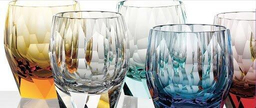Firozabad Glass Industry

FIROZABAD GLASS INDUSTRY
Glass is a unique material for the expression of art and craft. Amongst all material, it offers the highest degree of flexibility for shaping into a wide variety of products varying in design, forms, color and appearance. Firozabad, located in western Uttar Pradesh, India, is a huge industrial base for glass manufacturing and provides employment to a lot of craftsmen in and around the city. More than 80% of all utility-based glass products for India’s domestic market are produced in this city for many decades now. Also known as ‘Suhaag Nagri’, Firozabad is the centre of India's glassmaking industry and is famous for the bangles and all sorts of glass work, not only in India but also globally.
EMERGENCE OF FIROZABAD AS GLASSWARE HUB
During ancient times, invaders brought many glass articles to India. These glass articles, when rejected, were collected and melted in locally made furnaces called "Bhainsa Bhatti." In this furnace, wood was used as a fuel. These old traditional furnaces are still in use in Sasani near Aligarh and at Purdal Nagar and were originally used only for making smaller bottles and bangles. By current production standards, only one bangle at a time can be made using these furnaces. These bangles had no joints and were locally known as "Kadechhal Ki Chudi". Over time, production slowly became more widespread among the locals. This was the start of the glass industry in Firozabad. Since then Firozabad has been the home of India's glass industry. White and coloured glass pieces being manufactured for the purpose of assembling jhad and fanus (chandeliers) which were in demand by royal courts and nobles for decorating their assembling and drawing rooms. Later on phials for Itra, scents, and other cosmetic products were made. Gradually, Indian marriage items like bangles, kangans, kada, etc. too began to be produced in bulk for the general public. There is an area known as Bohran Gali that sells bangles, kadas, kangans and other items of married women. The glass industry specially the modern glass bangles technology was started and invented by Haji Rustam Ustad.
Since 1989, Firozabad has produced artistic glassware in different colours and shades used in chandeliers and other items. About four hundred glass industries are registered in Firozabad, making different types of glass products. They use natural gas instead of coal. Half of the
production of these units is exported. Nowadays, blowing/modeling is done by the Pot furnace and Regenerative tank furnace in the factories.
Firozabad with the changing time has entered into new era of Glass Manufacturing, it has become a major hub of manufacturing different Glass based items and has registered its global presence, diversifying its industrial base and encouraging ancillary industries including Chemicals, Packaging and more of service sector based industries have flourished in a short span of time.
PRODUCTION OF GLASSWARE:
Firozabad is engaged in manufacturing many types of glass products items like bangles, lamps, chandeliers, drinking glasses, jugs, bottles, and other glass utilities, even the headlight of vehicles. Most of the units in the city run twenty-four hours. They use pot furnaces, regenerative tank furnaces or fully automatic furnaces for making glassware. The first two use natural gas burners instead of coal and are made of firebricks.
The most familiar type of glass used for centuries in windows and drinking vessels is soda-lime glass, composed of about 75% silica, sodium oxide, calcium oxide and several minor additives. For mass production, this type of glass is melted in large gas fired units. Glass is totally recyclable. There are different types of processes for making bangles, tableware (glass-blowing) and small items like toys, and idols for worship etc. (glass-fusing).
Glass Blowing Process-
- Manual- A stream of molten glass, at its plastic temperature (1050°C-1200°C), is cut with a shearing blade to form a cylinder of glass, called a gob. The process starts with the gob falling, by gravity, and guided into the blank moulds, two halves that are clamped shut. Akarigar blows air into the hollow pipe from the other end to make the glass take the shape of the mould. Water is sprinkled over the mould to cool it off after every piece. The vessel is then picked up from the mould and kept to cool. As glass cools, it shrinks and solidifies. Uneven cooling causes weak glass due to stress and break. For even cooling, these are kept into an annealing oven that heats the container to about 580°C then cools it. Similar process is followed for making plates too but the only difference is that air is not blown into the pipe to make the plate take the shape of the mould. Molten glass is pressed in between two metallic die plates.
- Automatic- The glass shells of bulbs (that we use at home) are all made by the ‘forming machines’. These are fully automatic. Generally powered by compressed air, the mechanisms are timed to coordinate the movement of all the parts of the machine. Silica is fed into the furnace once at the beginning and that keeps forming the molten glass that is the necessary ingredient for making any product. The Temperature controller monitors the temperature of each component of the machine. Once ready, the shell falls off gradually onto various conveyor belts of controlled temperature. The rejects of the entire process are put back into the furnace for recycling. One more quality check is done manually and the product is ready to be packaged and shipped.
Bangle Making Process-
Bangles are also made with soda glass. Coloring agents are added to the molten glass in the furnace. The craftsman gets this from the furnace on a metallic pipe and gives it to another. He puts a wire of this glass onto a rod that constantly rotates on a motor. So the thin glass coils around the rod and takes the shape of the bangle. These rods are of different diameters depending on the size of the bangle to be made. One more craftsman sitting at the other end of the furnace holds a big metallic ruler or a pointed tool that prevents the bangles from sticking with each other. When the entire rod gets filled up, the bangles are removed and another glass stream is added. The entire coiling process generates a long glass spring of sorts. This is cut using a diamond cutter. This is what separates each bangle from the other. Now since these are open ended and not complete circles, these are taken home by another set of workers to be finished. They melt the glass slightly to join the open ends. This is called ‘kaanch taankna’ (stitching the glass). The bangles are further etched upon and polished to be sold in the market.
Glass Fusing Process-
Glass-fusing is another very interesting process to make products that require fine detailing. Through this method we get the the most astonishing idols for worship - Radha Krishna, Ganesha, Shiva Parvati, Ram Sita etc. Here basic raw materials include ‘Chinese glass’ (borosilicate glass that melts at a higher temperature than ordinary silicate glass), natural gas and oxygen burners, iron tong, carbon base (that doesn’t burn with heat) and golden polish (to highlight the features of the figurines). After melting and fusing glass into the product, craftsmen paint it golden and send it for another round of firing that makes the gold ‘pakka’.
PRODUCTS:
Although it is particularly famous for its bangles, but there is a lot more to Firozabad than just bangles. It is one of the most important industrial clusters for mass production of utility and decoration-based glass products. The range includes jars, candle stands, glasses, flower vases, electric wares such as decorative lights, bulbs, lamps, chandeliers, Gods and Goddesses, bangles etc. Sometimes, these articles are painted with vivid colors and innovative patterns to enhance their beauty.
This city is also home to a community of craftsmen who practice lamp work with glass rods to create a wide variety of exemplary handcrafted products. Glass rod is melted on a flame torch, to be shaped into complex, fluid and outstanding sculptural objects of beauty and use. Their skills are comparable if not better to the best glass artists in the world.
Since the Mughal period, Firozabad has been producing different shapes and shades of magnificent hanging chandeliers. Many innovative designs have been added to suit different tastes. Most of the fancy chandeliers that we see in showrooms and hotels these days are usually made in Firozabad, and are being exported to many other countries.
Firozabad glass industry for the last two centuries has been involved in manufacturing drinking glasses, beer glasses, wine glasses, dinner sets consisting of bowls, plates, lemon-sets, pudding sets, pitchers, tumblers etc. in attractive cuttings and charming designs. Over the past few years, the consumers have been replacing old-fashioned designs with new fashionable products such as glass tableware products. Also, the growing catering and hotel industry at the global level owing to the increased popularity of dine-out among masses is projected to expand the scope for glass tableware with aesthetic appeal. Glass utensils also symbolize a luxury lifestyle, which, in turn, is boosting the demand for the glass tableware. Firozabad’s glass utensils are high in demand and the expert craftsmen include modern touch to their ware due to changing trends and demands.
Despite producing world class glass products and contributing well to the country’s economy, Firozabad glass sector is going through a lot of challenges. The biggest challenge for the market is to shift factories somewhere else as it falls in the TTZ (Taj Trapezium Zone) region. Second, there is a shortage of skilled workers and the third difficulty is that factory workers work in extreme conditions, high temperatures and toxic gas, which in turn cause various diseases. Natural gas fuel price is another issue which businesses are fighting against.
Glass is the only material which is eco-friendly and is used for various purposes from kitchen to living room. But in the past 10 to 15 years, cheap plastic has taken over glass products.
Consumers are buying plastic over glass as it is easily available and is not expensive and, most importantly, unbreakable. According to the ASSOCHAM whitepaper on the glass sector, it's an extremely energy efficient industry. Paper states, “as every tonne of glass recycled saves 322KwH of energy, 246 kg of CO2 and 1.2 tonnes of virgin raw material, it helps in savings on waste transport and disposal costs, product packaged in glass denotes premiumness in terms of quality and care of the packaging of the product, and glass reduces the quantity of waste to be treated or dumped.” Further in the paper, ASSOCHAM recommends that the people should be made aware about the benefits of using glass for various purposes through awareness campaigns.
On the bright side, today technology has taken over and a number of manufacturers have transformed their businesses. The government setup, Centre for Development of Glass Industry (CDGI), under MSME ministry, is lending businesses training and providing machines. Earlier it was a manual process. CDGI helped it with transformation. Indeed, in the past few years glass industry has transformed itself from cottage to fairly organised industrial sector, from rudimentary mouth blown and hand working process to modern techniques with assistance of government initiatives. There is a great potential that is yet to be tapped, but first the sector needs a lot more attention than it is getting. First and foremost, there is a pressing need to create awareness among people about the benefits of using glass over plastic. In a world dominated by one-time use, cheap materials with very low value, glass stands out as a highly- valued collectible material.
 1,12,000 Artisans shops
1,12,000 Artisans shops
.png)
